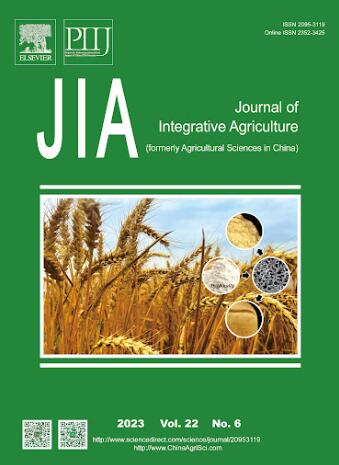遮阳和涝害的相互作用会减少同化物的积累和再动员过程,从而加剧夏玉米的产量损失
IF 4.4
1区 农林科学
Q1 AGRICULTURE, MULTIDISCIPLINARY
引用次数: 0
摘要
持续阴雨是限制夏玉米产量的一个重要因素,其直接影响是渍水和遮光的双重压力。然而,关于涝害和遮荫的独立效应和联合效应导致玉米产量损失的机理研究很少,尤其是在不同生长阶段。研究选择了登海 605(DH605),在第 3 叶期(V3)、第 6 叶期(V6)和抽穗期(VT)分别对其施加遮荫、渍水及其联合胁迫。结果表明,遮光、涝害及其联合胁迫显著限制了叶面积的扩大,降低了叶片净光合速率()和净同化速率(NAR),从而降低了作物生长速率(CGR)和生物量积累。同时,与对照相比,胁迫处理抑制了木质素的合成过程,导致茎杆机械强度降低,维管束系统发育不良,这些变化显著降低了同化物向穗部再动员的效率,最终降低了谷物产量。涝害和综合胁迫对产量的影响在 V3 阶段最为明显,其次是 V6 和 VT 阶段。遮荫对产量影响最大的是 VT 期,其次是 V6 和 V3 期。此外,复合胁迫加剧了单一胁迫带来的损害。据预测,气候变化将增加非生物胁迫组合的频率,这些研究结果为今后在连续多雨条件下进一步研究夏玉米育种提供了一些方向。本文章由计算机程序翻译,如有差异,请以英文原文为准。
Shading and waterlogging interactions exacerbate summer maize yield losses by reducing assimilate accumulation and remobilization processes
Persistent overcast rain was an essential limiting factor for summer maize production, of which immediate impact was the dual pressure of waterlogging and shading. However, the mechanism of independent and combined effects of waterlogging and shading induced maize yield losses are rarely studied, especially at different growth stages. Denghai 605 (DH605) was selected to be subjected shading, waterlogging, and their combined stress at the 3rd leaf stage (V3), the 6th leaf stage (V6), and tasseling stage (VT). Results showed that shading, waterlogging and their combination significantly limited the expansion of leaf area, and decreased leaf net photosynthetic rate () and net assimilation rate (NAR), thus reducing the crop growth rate (CGR) and biomass accumulation. At the same time, compared to control, the process of lignin synthesis was inhibited under stressed treatment, resulting in reduced stem mechanical strength and a poor development of the vascular system, of which change significantly reduced efficiency of assimilate remobilization to the ear and ultimately grain yield. The most significant effects of waterlogging and combined stresses on yield were occurred at V3 stage, followed by the V6 and VT stages. The most significant effects of shading were occurred at VT stage, followed by the V6 and V3 stages. Moreover, the compound stress exacerbated the damage brought about by a single stress. It is predicted that climate change will increase the frequency of abiotic stress assemblages, and the results of these findings provide some direction for further research on maize breeding in summer maize under continuous rainy conditions in the future.
求助全文
通过发布文献求助,成功后即可免费获取论文全文。
去求助
来源期刊

Journal of Integrative Agriculture
AGRICULTURE, MULTIDISCIPLINARY-
CiteScore
7.90
自引率
4.20%
发文量
4817
审稿时长
3-6 weeks
期刊介绍:
Journal of Integrative Agriculture publishes manuscripts in the categories of Commentary, Review, Research Article, Letter and Short Communication, focusing on the core subjects: Crop Genetics & Breeding, Germplasm Resources, Physiology, Biochemistry, Cultivation, Tillage, Plant Protection, Animal Science, Veterinary Science, Soil and Fertilization, Irrigation, Plant Nutrition, Agro-Environment & Ecology, Bio-material and Bio-energy, Food Science, Agricultural Economics and Management, Agricultural Information Science.
 求助内容:
求助内容: 应助结果提醒方式:
应助结果提醒方式:


